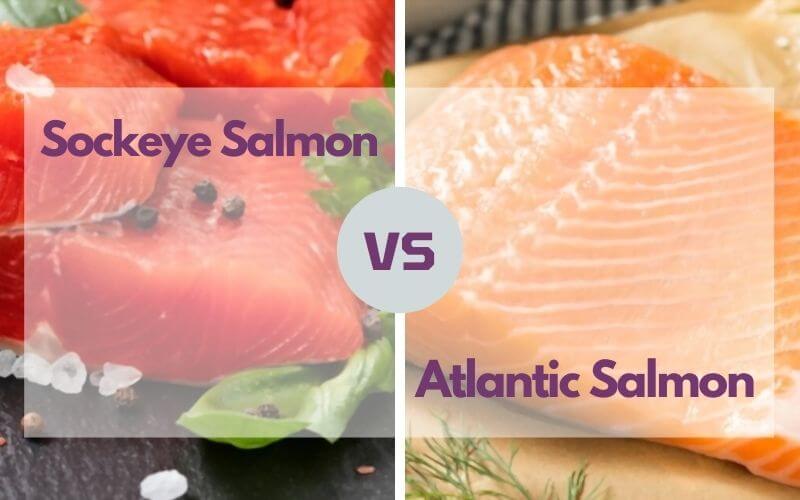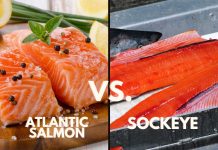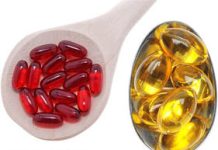The Battle of the Salmon: Sockeye vs. Atlantic
Salmon is a highly popular and nutritious fish that has sparked an ongoing debate between sockeye and Atlantic salmon. This article aims to provide an in-depth comparison of these two types of salmon, highlighting their distinct characteristics, nutritional value, culinary uses, and environmental impact. By understanding the differences between sockeye and Atlantic salmon, consumers can make informed choices based on their preferences and health considerations.
Sockeye Salmon

Sockeye salmon, also known as red salmon, is a species native to the Pacific Ocean. It is known for its vibrant red flesh and rich flavor. Sockeye salmon typically spawn in freshwater rivers and lakes before migrating to the ocean. They have a unique ability to navigate long distances and overcome obstacles during their annual migration.
Physically, sockeye salmon have a streamlined body with a bluish-green back and silver sides. They are smaller in size compared to Atlantic salmon, averaging around 5-7 pounds. Sockeye salmon are prized for their firm texture and intense flavor, making them a favorite among seafood enthusiasts.
From a nutritional standpoint, sockeye salmon is a powerhouse of essential nutrients. It is an excellent source of omega-3 fatty acids, which are known for their heart-healthy benefits. Sockeye salmon is also packed with vitamins B12 and D, selenium, and phosphorus. Regular consumption of sockeye salmon can support brain health, boost immune function, and reduce the risk of chronic diseases.
Culinarily, sockeye salmon is incredibly versatile. It can be enjoyed raw in sushi or sashimi, grilled, baked, broiled, or even smoked. Popular recipes include cedar-planked salmon, salmon burgers, and salmon salads. The distinct flavor of sockeye salmon pairs well with tangy and acidic ingredients like lemon, dill, and capers.
Exploring Atlantic Salmon
Atlantic salmon, also known as Salmo salar, is native to the rivers of Europe and North America. It has been extensively farmed and has gained popularity worldwide. Atlantic salmon has a milder flavor compared to sockeye salmon, making it appealing to a broader range of palates.
In the wild, Atlantic salmon can be found in the northern Atlantic Ocean, particularly in regions like Norway, Scotland, and Canada. They have a silvery-blue color with black spots on their back and upper body. Atlantic salmon are generally larger than sockeye salmon, with average weights ranging from 10-20 pounds.
From a nutritional perspective, Atlantic salmon is also an excellent source of omega-3 fatty acids, although it contains slightly less than sockeye salmon. It is rich in protein, vitamin D, vitamin B12, and selenium. Regular consumption of Atlantic salmon can support heart health, improve brain function, and promote healthy skin.
When it comes to cooking, Atlantic salmon offers great versatility. It can be grilled, pan-seared, baked, poached, or used in dishes like salmon en croute or salmon pasta. The milder flavor of Atlantic salmon pairs well with creamy sauces, herbs like dill and tarragon, and citrus flavors.
Comparing Flavor and Texture
The flavor and texture of sockeye and Atlantic salmon differ significantly, catering to different preferences. Sockeye salmon is known for its robust, rich flavor with a hint of natural sweetness. It has a firm texture that holds up well to various cooking methods, making it an excellent choice for grilling, broiling, or searing. The higher fat content in sockeye salmon contributes to its intense flavor and moist texture.
On the other hand, Atlantic salmon has a milder and more delicate flavor compared to sockeye salmon. It has a softer texture and tends to be more buttery and tender when cooked. Atlantic salmon is often preferred by those who prefer a less pronounced fish flavor. It is well-suited for cooking techniques like baking, poaching, or incorporating into dishes that require a more subtle taste.
Ultimately, the choice between sockeye and Atlantic salmon comes down to personal preference and the specific dish being prepared. It’s worth experimenting with both types to discover which flavor and texture profile you enjoy the most.
Nutritional Value Showdown
When it comes to nutritional composition, both sockeye and Atlantic salmon offer impressive health benefits.
Sockeye salmon is renowned for its high omega-3 fatty acid content. Omega-3 fatty acids are essential fats that play a crucial role in heart health, brain function, and reducing inflammation in the body. Sockeye salmon contains approximately 1.5 grams of omega-3 fatty acids per 3-ounce serving, making it an excellent choice for those looking to increase their intake of these beneficial fats. Additionally, sockeye salmon is a good source of protein, vitamin B12, vitamin D, selenium, and phosphorus.
Atlantic salmon also provides a notable amount of omega-3 fatty acids, although slightly lower compared to sockeye salmon. It contains around 1 gram of omega-3 fatty acids per 3-ounce serving. However, it remains a valuable source of protein, vitamin D, vitamin B12, selenium, and other essential nutrients.
Both types of salmon offer similar health benefits, including reducing the risk of heart disease, improving brain function, supporting eye health, and promoting healthy skin. The omega-3 fatty acids found in salmon have been associated with a lower risk of chronic diseases such as diabetes, certain cancers, and cognitive decline.
While salmon is generally a nutritious food choice, it’s essential to consider potential contaminants such as mercury and PCBs. These contaminants can be found in varying levels in both wild-caught and farmed salmon. However, the overall levels of contaminants in both sockeye and Atlantic salmon are relatively low and considered safe for consumption according to regulatory guidelines.
Consumers should prioritize purchasing salmon from reputable sources that follow sustainable fishing or farming practices to minimize the potential environmental impact and ensure the highest quality and safety standards.
Environmental Impact and Sustainability
The environmental impact of salmon farming and fishing practices differs between sockeye and Atlantic salmon.
Sockeye salmon is primarily caught in the wild, with sustainable fishing practices in place to protect wild salmon populations. These practices include setting fishing quotas, implementing fishing gear modifications to reduce bycatch, and protecting critical spawning grounds. However, certain challenges, such as habitat destruction and climate change, can still impact wild sockeye salmon populations.
Atlantic salmon, on the other hand, is predominantly farmed. Salmon farming has faced criticism due to concerns over water pollution, disease transmission, and the use of antibiotics and pesticides. However, sustainable aquaculture practices are being adopted to address these issues. These practices include minimizing environmental impact, improving fish welfare, and sourcing sustainable feed ingredients.
When purchasing salmon, look for certifications such as the Marine Stewardship Council (MSC) for wild-caught salmon or the Aquaculture Stewardship Council (ASC) for responsibly farmed salmon. These certifications ensure that the salmon has been sourced from sustainable and well-managed fisheries or farms.
By supporting sustainable salmon fishing or farming practices, consumers can contribute to the conservation of wild salmon populations and the protection of aquatic ecosystems.
Health Considerations and Contaminants
While salmon is generally considered a healthy food choice, it’s important to be aware of potential contaminants and take necessary precautions.
Mercury and PCBs (polychlorinated biphenyls) are two common contaminants that can be found in varying levels in fish, including salmon. These contaminants are primarily a concern for larger fish that have longer lifespans and are higher on the food chain. However, the levels of contaminants in both sockeye and Atlantic salmon are generally considered to be low and safe for consumption.
To minimize exposure to contaminants, it is recommended to follow these guidelines:
Choose salmon from reputable sources that prioritize quality and safety standards.
Consider consuming a variety of fish to minimize exposure to any single contaminant.
Trim the skin and fat of the salmon, as contaminants tend to accumulate in these areas.
Opt for smaller-sized salmon, as they typically have lower levels of contaminants.
Avoid consuming raw or undercooked salmon, as cooking can help reduce the presence of contaminants.
By being mindful of the source and quality of the salmon you consume and following these guidelines, you can enjoy the health benefits of salmon while minimizing potential risks.
Culinary Recommendations and Recipes
Both sockeye and Atlantic salmon offer a wide range of culinary possibilities. Here are some cooking tips and popular recipes for each type of salmon:
Sockeye Salmon:
Grilling: Sockeye salmon’s firm texture makes it ideal for grilling. Brush the salmon with olive oil, season with salt and pepper, and grill over medium heat for about 4-6 minutes per side.
Baking: Preheat the oven to 375°F (190°C). Place the sockeye salmon fillets on a baking sheet lined with parchment paper. Drizzle with lemon juice, sprinkle with herbs like dill or thyme, and bake for 12-15 minutes or until the salmon is cooked through and flakes easily with a fork.
Cedar-Planked Salmon: Soak a cedar plank in water for about 1 hour. Place the sockeye salmon fillet on the plank, season with your choice of spices or marinade, and grill over medium heat for 12-15 minutes or until done.
Atlantic Salmon:
Poaching: Fill a large skillet with water or broth, and add aromatics like lemon slices, herbs, and spices. Bring to a simmer, then carefully add the Atlantic salmon fillets. Poach for about 8-10 minutes or until the salmon is opaque and flakes easily.
Baked Salmon en Croute: Roll out puff pastry into a rectangle, place the seasoned Atlantic salmon fillet in the center, and fold the pastry over the fish. Brush with an egg wash, and bake in a preheated oven at 400°F (200°C) for 20-25 minutes or until the pastry is golden brown.
Salmon Pasta: Cook your favorite pasta according to package instructions. In a separate pan, sauté diced onions and garlic in olive oil. Add diced Atlantic salmon, cherry tomatoes, and a splash of white wine. Cook until the salmon is cooked through. Toss the cooked pasta with the salmon mixture and finish with fresh herbs like parsley or basil.
Remember to experiment with different flavors, herbs, and cooking methods to find your favorite way to enjoy sockeye or Atlantic salmon. Pair your salmon dishes with side dishes like roasted vegetables, quinoa, or a fresh salad for a complete and nutritious meal.
FAQs
What is the difference between sockeye and Atlantic salmon?
Sockeye salmon is native to the Pacific Ocean and is known for its vibrant red flesh and rich flavor. Atlantic salmon, on the other hand, is native to the rivers of Europe and North America and has a milder flavor. They also differ in their physical appearance, with sockeye salmon being smaller in size compared to Atlantic salmon.
Which type of salmon is better for grilling?
Sockeye salmon is often preferred for grilling due to its firm texture and intense flavor. The higher fat content in sockeye salmon helps keep it moist and flavorful when exposed to the heat of the grill.
Are there any notable taste differences between sockeye and Atlantic salmon?
Yes, there are taste differences between sockeye and Atlantic salmon. Sockeye salmon has a robust, rich flavor with a hint of natural sweetness, while Atlantic salmon has a milder and more delicate flavor. The choice between the two depends on personal preference.
Is one type of salmon more sustainable than the other?
Both sockeye and Atlantic salmon can be sourced sustainably. When purchasing salmon, look for certifications such as the Marine Stewardship Council (MSC) for wild-caught salmon or the Aquaculture Stewardship Council (ASC) for responsibly farmed salmon to ensure sustainability.
Are there any health risks associated with consuming salmon?
While salmon is generally considered a healthy food choice, it’s important to be aware of potential contaminants such as mercury and PCBs. However, the levels of contaminants in both sockeye and Atlantic salmon are generally low and safe for consumption when following recommended guidelines.
How often should I consume salmon for optimal health benefits?
Including salmon in your diet a few times a week can provide you with a good amount of omega-3 fatty acids and other essential nutrients. However, individual dietary needs may vary, so it’s best to consult with a healthcare professional for personalized advice.
Can I substitute sockeye salmon for Atlantic salmon in recipes?
Yes, you can substitute sockeye salmon for Atlantic salmon and vice versa in most recipes. Just keep in mind that sockeye salmon has a stronger flavor, so it may have a more pronounced impact on the overall taste of the dish.
Are there any specific cooking techniques that work best for each type of salmon?
Sockeye salmon is well-suited for grilling, broiling, or searing due to its firm texture. Atlantic salmon is great for baking, poaching, or incorporating into dishes that require a more delicate flavor. However, both types of salmon can be cooked using various techniques based on personal preference.
What are the main factors to consider when buying salmon?
When buying salmon, consider factors such as the source (wild-caught or farmed), sustainability certifications, freshness, and the reputation of the supplier or brand. Look for salmon with vibrant color, firm texture, and no strong fishy odor.
How can I ensure the salmon I purchase is of high quality?
To ensure high-quality salmon, purchase it from reputable seafood markets, grocery stores, or online suppliers. Look for certifications that guarantee sustainable sourcing and check for freshness indicators such as the date of packaging or harvest. Trustworthy suppliers prioritize quality and adhere to strict standards.
Conclusion
The battle between sockeye and Atlantic salmon is a testament to the popularity and versatility of this nutritious fish. Understanding the unique characteristics, flavors, and nutritional profiles of each type of salmon allows individuals to make informed choices based on their preferences and health considerations. Sockeye salmon, with its vibrant red flesh, rich flavor, and firm texture, is a favorite among seafood enthusiasts. It is packed with omega-3 fatty acids, vitamins, and minerals, offering numerous health benefits. Sockeye salmon shines in grilling and other high-heat cooking methods.




